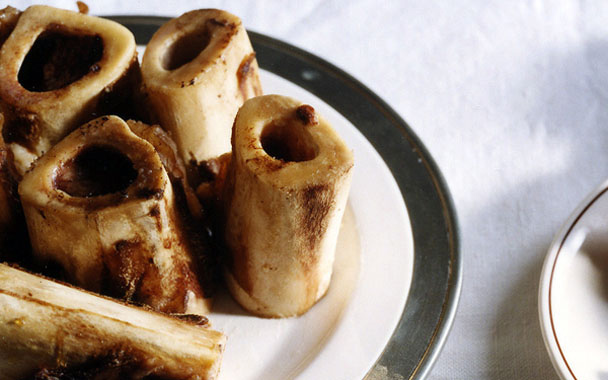For my birthday last week my wife, Tara, roasted veal marrow bones we’d bought from Flying Pigs Farm and served them, in the style of London’s St. John restaurant, with grilled bread and a salad of parsley and capers. She brought the bones right from the oven to the table, where we dug the marrow out of the browned, crispy ends, spread it on grilled bread, then topped it with a sprinkle of salad and a grinding of sea salt. It’s a simple, brilliant dish—the crunch and heft of the bread against the marrow, soft and just starting to melt, unctuous and silky like great butter, but with an animal ferocity that’s matched head-on by the aggressive sharpness of the salad and the savory counterpoint of the salt. It’s unapologetically carnivorous, and a good chance to reflect on what it took to feed ourselves with some other creature’s bones.
“You know what happens to a male calf born on a dairy farm?” Jen Small from Flying Pigs was explaining to me how they had come to offer veal this fall along with their excellent pork and chickens. “They have from whatever day they’re born to the following Tuesday, when they go to auction and then directly to the slaughterhouse. And the farmers get almost nothing for them,” she said. “So I asked Mike if we couldn’t try to give them a reasonable life for at least a few months. We bought three calves from a neighbor in April, bottle-fed them for a few weeks, then turned them out to pasture until October.” And then, of course, Jen and Mike brought those animals to the slaughterhouse themselves. Flying Pigs veal is subtler then beef, but it isn’t white—it’s red with iron from the grass those calves ate while wandering around in the fields.
In what now seems like a particularly prescient section of The Omnivore’s Dilemma, Michael Pollan considers what might happen if our abattoirs were made of glass. It’s a great metaphor for thinking about what we’d do if we could see clearly what happened to our food on its way to our plate. But transparency can just as easily be a Saturday morning conversation at the farm stand with someone who cared for the animal you’re about to cook. It’s possible, I think, to indulge in pleasures of the flesh (eating meat, in other words) in a way that doesn’t ignore the fact that sentient animals are being raised and then killed to satisfy that urge. It seems only right to savor every last bit of them.




 Pinterest
Pinterest


